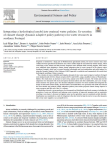Dias L.F., Aparício B.A., Nunes J.P., Morais I., Fonseca A.L., Pastor A.V., Santos F.D. (2020). Integrating a hydrological model into regional water policies: co-creation of climate change dynamic adaptive policy pathways for water resources in southern Portugal. Environmental Science & Policy, 01/12/2020, vol. 114, p. 519-532.
https://doi.org/10.1016/j.envsci.2020.09.020
https://doi.org/10.1016/j.envsci.2020.09.020
| Titre : | Integrating a hydrological model into regional water policies: co-creation of climate change dynamic adaptive policy pathways for water resources in southern Portugal (2020) |
| Auteurs : | L.F. Dias ; B.A. Aparício ; J.P. Nunes ; I. Morais ; A.L. Fonseca ; A.V. Pastor ; F.D. Santos |
| Type de document : | Article |
| Dans : | Environmental Science & Policy (vol. 114, December 2020) |
| Article en page(s) : | p. 519-532 |
| Langues : | Anglais |
| Langues du résumé : | Anglais |
| Catégories : |
Catégories principales 07 - ENVIRONNEMENT ; 7.3 - Eau. Gestion de l'EauThésaurus IAMM GESTION DES EAUX ; MODELE ; RESSOURCE EN EAU ; CHANGEMENT CLIMATIQUE ; EAU DISPONIBLE ; POLITIQUE ; PORTUGAL |
| Résumé : | Irrigation is essential for a large part of Mediterranean agricultural systems, but scarce resources may cause conflicts between agricultural and domestic uses. These conflicts might be exacerbated by climate change, which could bring a drier climate and thus increase irrigation water demands while lowering supplies. These issues were addressed when designing a climate change adaptation plan for water resources in the Algarve region (southern Portugal), which was co-created between hydrologists and local stakeholders and policy-makers, by using the Dynamic Adaptive Policy Pathways (DAPP) approach to synthetize and communicate the results from hydrological modelling of future scenarios. The evolution of water availability and irrigation demands for key water assets in Algarve (southern Portugal) were simulated until 2100 for climate scenarios RCP4.5 and RCP8.5, using a modified version of Thornthwaite-Mather. The results show an increase in water stress, mainly in the RCP8.5 scenario. The results and need for adaptation were discussed with local and regional decision-makers and other stakeholders, and a set of adaptation measures was agreed upon. The discussed adaptation measures were then modelled and integrated the design of tailor-made DAPP. Finally, decision-makers and stakeholders were presented with DAPP and selected the most suitable and political reliable adaptation pathway that tackles projected climate change impacts in water resources until the end of the 21 st century. Stakeholders showed a strong preference for incremental and distributed small-scale measures, including the promotion of water use efficiency and landscape water retention, to large-scale measures such as wastewater recycling or new dams. A decrease in irrigation water use for agriculture was not considered socially desirable. Desalination was considered too costly for irrigation in the short term but kept in reserve in case other measures fail to keep water supplies at an acceptable level. |
| Cote : | Réservé lecteur CIHEAM |
| URL / DOI : | https://doi.org/10.1016/j.envsci.2020.09.020 |







